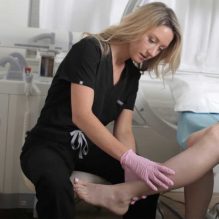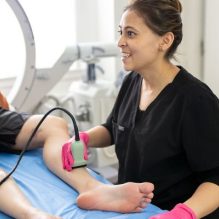Radiofrequency Ablation is used to treat varicose veins diseases. It is a minimally invasive treatment procedure. This procedure uses radiofrequency energy to heat up and damage the affected veins. This technique closes the varicose veins completely.
Under this procedure, the radiofrequency is directed inside the affected vein using a thin catheter tube inserted through a small incision. It is done in the doctor’s office with the help of local anesthesia. You will be able to walk soon after the completion of the radiofrequency ablation procedure and it needs very less recovery time.

After the successful completion of the process, you have to wear compression stockings for at least a week. To confirm the closing of the vein the doctor will use a duplex ultrasound.
However, many questions occur in your mind before going for radiofrequency ablation. Here is a list of few questions with answers to help you out to understand the process better.
How does it work?
The RF ablation device heats up the wall of the defective vein causing it to seal permanently. After the closure of the vein, the blood will be re-routed to healthier veins. And the unhealthy vein is absorbed by the body.
Is Radiofrequency Ablation Painful?
RF ablation is a non-surgical minimally invasive procedure. It is also used for pain treatment. Radiofrequency ablation may cause a little discomfort, but some people feel minimal pain. The vein specialists use local anesthesia to numb the area. You may feel night time cramping, bruising and swelling for a few days after the treatment. However, painkillers are prescribed by the doctor to minimize the effect.
Is RF Ablation Safe?
RF ablation is a safe procedure but it includes some side effects. The possible side effects of RF ablation are:
- Burning of skin
- Burning sensation
- Pain or prickling after recovery
- Blood clotting in the vein
To minimize these side effects, get treated by the best vein specialist. The experienced vein specialist will take some preventive measures to minimize the risk.
Radiofrequency ablation is an affordable treatment. It is available at a very low cost and can be performed in the doctor’s office. You don’t have to be admitted to the hospital hence; the admission charges also don’t apply.
How Much Recovery Time is Needed After This Procedure?
The patient can recover within 2-4 weeks after the successful completion of treatment. The maximum benefit is seen after the second week of the treatment and it lasts up to 8-12 months.
Do Veins Recur After Removal?
Well, none of the vein treatment procedure guarantees a permanent solution for varicose veins. Veins may recur after a few years. Sometimes, the laser treatment doesn’t seal a vein properly which leads to the flow of blood in the leg veins causing varicose veins to reappear.
Vein Treatment Clinic has the best vein specialist for performing the radiofrequency ablation successfully. Our specialists are trained from top medical institutes. To know more about the cost and other information about the treatment, feel free to contact us through our official website veintreatmentclinic.com.





